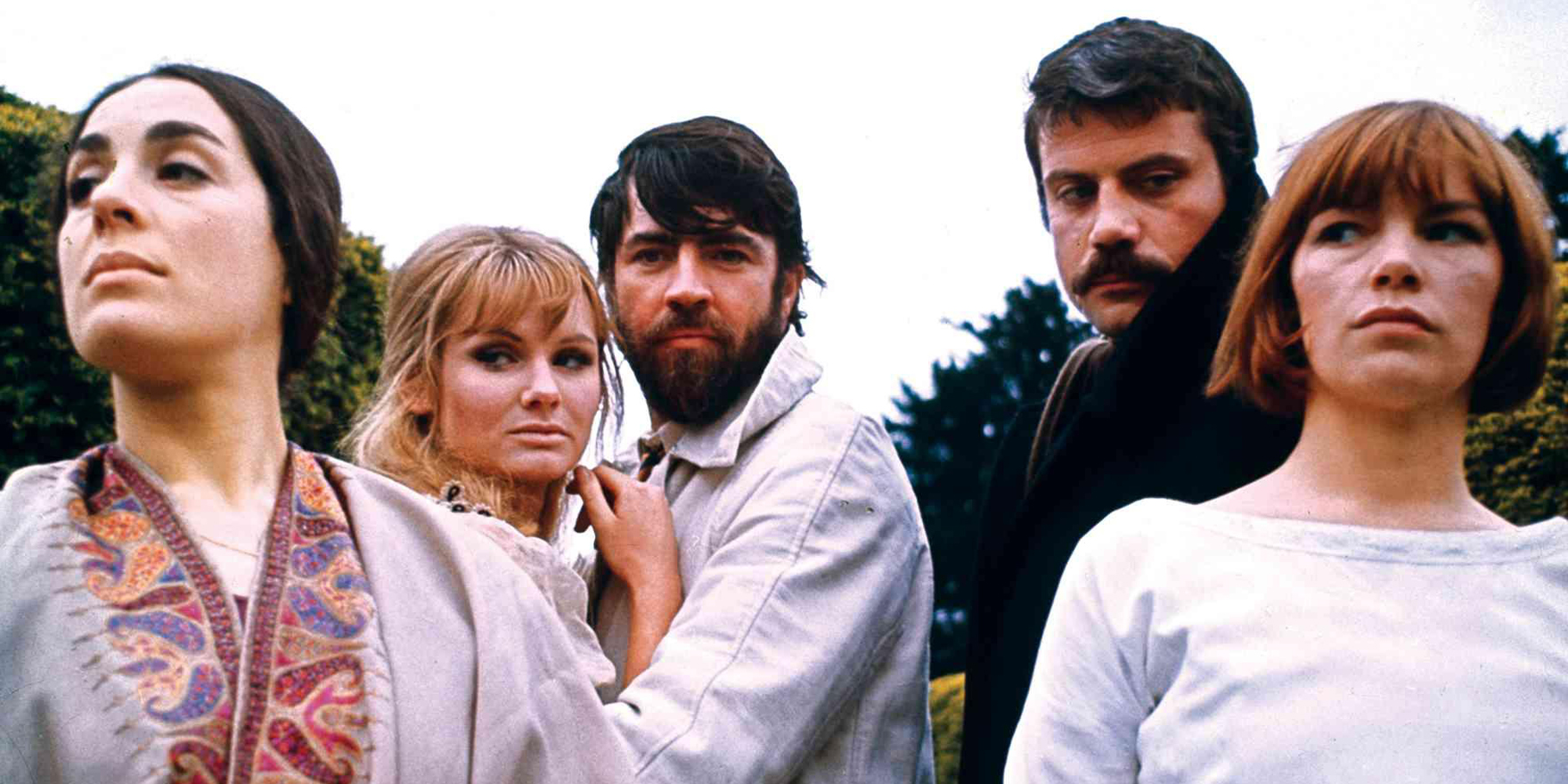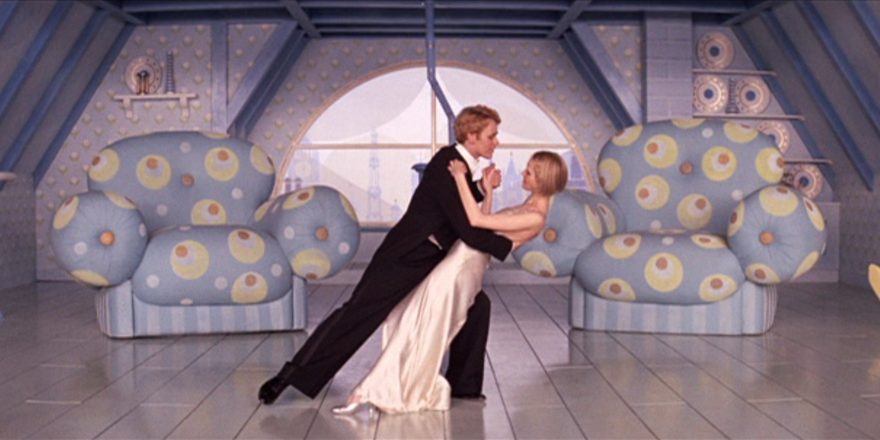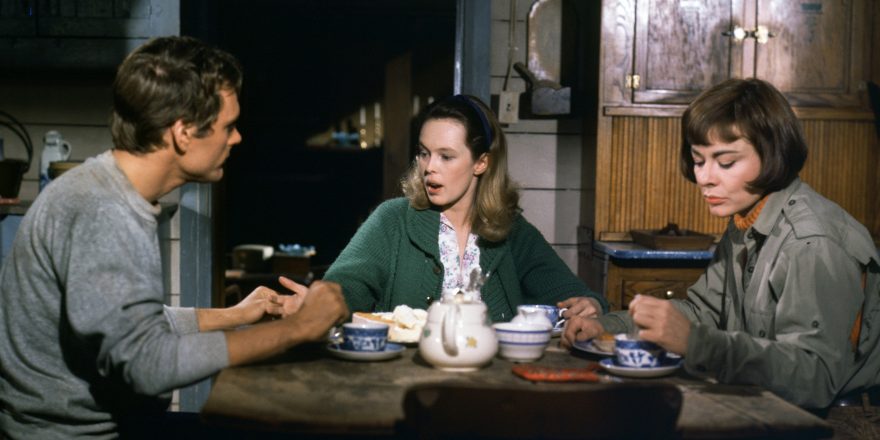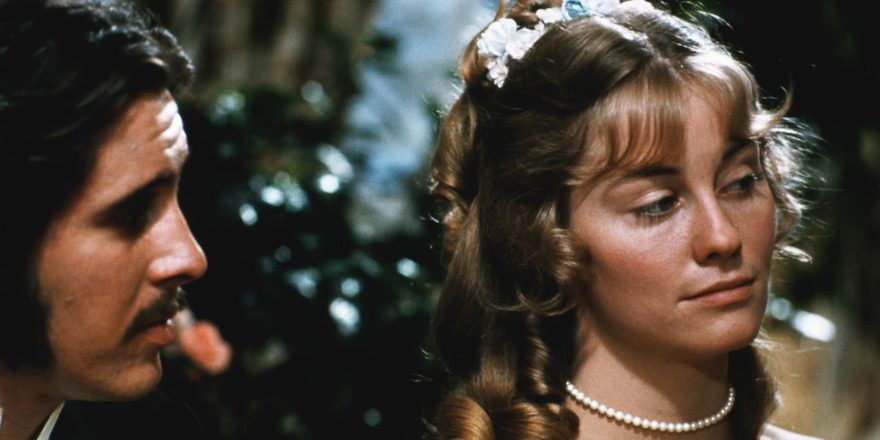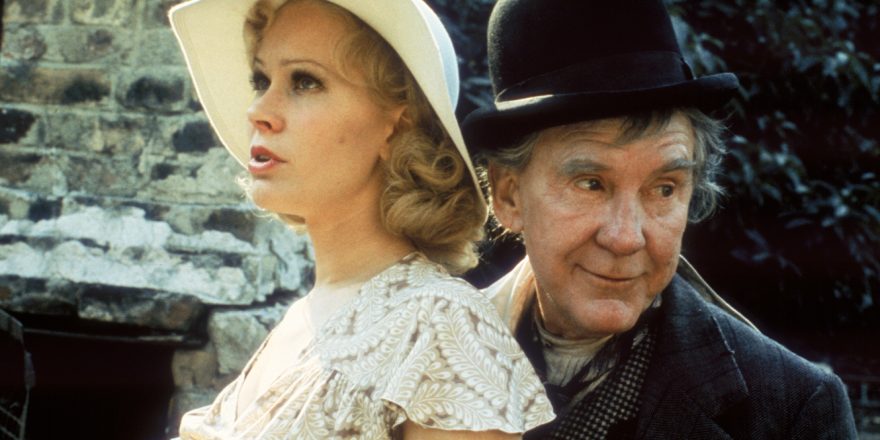What to make of the strange case of Ken Russell, one of the most perverse and problematic yet strangely compelling British film directors of the past 50 years? Russell’s work was always far campier than that of any of his contemporaries (The Boy Friend is undeniably one of the campiest – and worst – movies of the 1970s), even the ones that were actually gay, like Tony Richardson and John Schlesinger, who only rarely let their camp flags fly. Although all three directors had recurring themes of homosexuality running through their films, it was Russell, married four times (to women) and with eight children, whose work – draw your own conclusions – exhibited the most tortured and conflicted homosexual characters, or at least those who repressed their homosexuality: Tchaikovsky in The Music Lovers (1970), Rudolph Valentino in Valentino (1977) (the stars of both films, Richard Chamberlain and Rudolf Nureyev, were problematically gay), and, arguably, Rupert Birkin (Alan Bates) in Women in Love (1969). At any rate, almost every Ken Russell film features the dissolution of a turbulent marriage, or in the case of the latter film, the utter impossibility of the state of matrimony, for both men and women.
Women in Love is not camp, but it is a queer brew indeed, not only directed by the sexually obsessed and complicated Russell, but also based on the brilliant, passionate novel by D.H. Lawrence, a bisexual artist deeply conflicted about his homosexual feelings, with a screenplay by … wait for it … Larry Kramer, the longtime AIDS activist who would become a moralistic advocate against gay “promiscuity” during the plague years. (His screenplay for the 1973 musical remake of Lost Horizon, an unintentional camp classic and major bomb, would be his last for the big screen.) The result is a brazen, paradoxical and, well, horny concoction, featuring several of the first instances of full-frontal male nudity ever in a theatrical film. It’s a movie that also happens to be highly feminist, in a good way, thanks both to the source material, and to the bravura, Oscar-winning performance of Glenda Jackson, who embodies the character of Gudrun Brangwen with startling authority.
The very first scene of Women in Love economically sets up its polemic against marriage as Gudrun and Ursula (a suitably typic Jennie Linden), stroll down the street discussing the dreary institution. Gudrun asks her sister if she doesn’t think marriage would be, at the very least, an experience, to which Ursula replies, “Not really. More like it would be the end of experience,” as they contemptuously watch a young married couple dutifully pushing a baby carriage. The anti-marriage trend extends to the next scene as the two women, on their way to the wedding of the daughter of wealthy mine owner Thomas Crich, discuss the same subject in a graveyard, one of the main symbolic sites of the equivalency of death and marriage (or sex) in the film. Russell is not the subtlest of directors, to put it generously – although this film, along with Savage Messiah, is one of his most (relatively) restrained and conventionally narrative – and Kramer’s adaptation is rather single-minded in its hammering home of Lawrence’s ideas, one portentous scene piled upon another. But somehow the net effect is a remarkable distillation and compounding of the ideas set forth in the original work, the passion and depth of feeling enhanced by Billy Williams’ lush and vibrant cinematography and the vivid period costumes by Shirley Russell, the director’s then-wife.
Schoolteachers Gudrun and Ursula become involved with, respectively, best friends Gerald Crich (Oliver Reed), son of Thomas, a wealthy industrialist, and Rupert Birkin (Alan Bates), a school inspector. Rupert is in the death throes of a relationship with the rich, eccentric Hermione Roddice (the wonderful Eleanor Bron), whose theatrical passion and jealousy prove more than he can take. Spending weekends together at Hermione’s country estate, Rupert mansplains the female genitalia in comparison to the fig in what could only be called an essentialist feminist manifesto, with an emphasis on the man. The sisters challenge the men and their philosophical pronouncements and pomposities at every turn, not letting them get away with anything. Meanwhile, in their own company, Gerald and Rupert stare into each other’s pellucid blue and green eyes, respectively, while the latter explains his ideas about the necessity of eternal love between men as well as with a woman, if only to remain unconsummated.
As a work by D.H. Lawrence, Women in Love is as much about class struggle as it is about sexual warfare. Gerald is updating his father’s coal mine to ensure maximum profit by exploitation of their workers, and through new technology, already an issue in 1920. (Thomas Crich points out to his son that there will soon be few workers left to pay when his “new machines” take over.) But as Rupert explains, class barriers are already breaking down, as he and the middle-class Brangwen sisters are allowed access to upper-class social circles.
When one randy miner takes her bait, she turns the tables on him with a vengeance. “How are your thighs?” she asks aggressively. “Are they strong? Because I want to drown in flesh. Hot, physical, naked flesh.”Rupert Birkin and Gudrun Brangwen are two of my favorite characters in literature, both intellectual yet libertine, class-conscious, yet socially mobile, and misanthropic yet having an unquenchable lust for life. Rupert is an exceedingly complex male character, vacillating wildly between atheism and pantheism, between the upper and lower classes, and between reason and madness. At a war memorial, he tells Ursula, “I abhor humanity. I wish it were swept away … and there would be no absolute loss if every human perished tomorrow.” When Gerald’s young sister and her new groom tragically drown on the night of their wedding, Rupert opines, “I don’t mind about the dead once they are dead. The worst of it is, they cling on to the living, and won’t let go.” And one of my favorite pronouncements by Rupert: “I prefer unlucky things. Luck is vulgar. Who wants what luck would bring? I don’t.” Contrarian and full of contradictions, Rupert and Gudrun are perfectly matched, and yet they have no sexual interest in one another. They both crave the same things, not each other.
The four main characters of Women in Love can be neatly divided in terms of Freud’s structural model of the psyche. Gerald represents the id, the unbridled, sexual beast, exploiter, and rogue, coded in the film as purely masculine. Ursula is the superego, the moralizing voice of civilization and normalcy, the triumph of the reality principle over the pleasure principle, represented as the purely feminine. Gudrun and Rupert are the two sides of the ego, each both feminine and masculine, both mediating between the amoral id and the all too moral superego. This schema is driven home in one striking scene, a majorly symbolic passage in the novel, in which the sisters witness Gerald on horseback racing a train. (Freud uses the analogy of horse and rider to describe the relationship between the id and the ego.) As the locomotive zooms past the road where the women stand, Gerald digs his spurs into the horse’s sides until it bleeds, torturing it with brute force as it rears back on its hind legs in pain and fright. Ursula, standing in for civilization, is terrified and disgusted by the spectacle, but Gudrun is clearly teeming with mixed emotions at this display of masculine power: disgust, horror, excitement and envy, all brilliantly conveyed by Jackson. The scene is somewhat “overdirected” by Russell, covering it with visual overload and bombastic camera work and editing, but fortunately Lawrence’s work does not particularly lend itself to restraint.
The subsequent remarkable scene, in which Gudrun fearlessly treads through the working class underbelly of the city, literally slumming in search of a member of the lumpenproletariat to have sexual congress with, illustrates most thoroughly the “good feminism” of Lawrence. Ogled and cat-called by filthy miners, one of whom says he’d pay a week’s wages to have her, Gudrun smiles at the compliment and forges on. In a thick Cockney accent, a whore yells at her, “You won’t get much for it down ‘ere, dearie,” which she also finds amusing. When one randy miner takes her bait, she turns the tables on him with a vengeance. “How are your thighs?” she asks aggressively. “Are they strong? Because I want to drown in flesh. Hot, physical, naked flesh.” When he lurches at her, she kicks him in the shins and says, “You are hideous and ridiculous like all the rest!” Gerald happens by with two whores and intervenes, but you get the impression Gudrun doesn’t need his help. Far from any model of victimization, she craves the experience of masculine power, tapping into her own id, but she doesn’t require its assistance. Independence is her true creed. The following scene, in which she stares down and scares away a menacing herd of long-horned cattle by dancing provocatively in front of them, reinforces her termerity, which she punctuates with a slap to Gerald’s face. “You’ve struck the first blow,” he tells her, to which she replies, “And I shall strike the last!”
The scenes of naked abandon in the film may verge on the ludicrous, but somehow Russell and his cinematographer manage to make them feel sensual, and necessary to convey Lawrence’s passions. After Hermione cracks Rupert’s skull with a marble egg for having the effrontery to ridicule her cerebral sexuality and lack of spontaneity, he runs naked, fully frontal, through a field and rolls sensuously in the grass, rubbing himself with it as if he could make communion with nature by sheer osmosis. Later, a scene of Ursula, who is coded as an Earth Mother despite her function as the tempering superego, dances naked through nature in slow motion, the camera capturing her sideways for the entire sequence. Although Russell’s erratic and jarring camera technique tends to bog down many of his later films, here it serves perfectly the liberation of the female characters emerging from a sexually repressive era.
The main set piece of the film, and the symbolic heart of the novel, is the drowning of the newlyweds in the small lake on the Crich estate. Lawrence is obsessed with the Freudian connection between the sex and death drives, and he often posits marriage as a kind of death (see also The Fox), so here is its most perfect expression, the bride and groom dying naked in each other’s arms on the night that was designed for the sexual consummation of their union. Russell conveys this cruel irony with a visual bluntness that is improbably effective, cutting starkly from Rupert and Ursula passionately making love, shot handheld, to the intertwined bodies of the newly married couple at the bottom of the drained lake. A cut back to the living couple, post-coital, has them in the exact same position as the dead, foreshadowing the unsatisfying and problematic monogamous union between Ursula and Rupert. “A permanent relationship between a man and a woman is certainly not the last word,” Rupert says later to Gerald, his image split in two by a mirror, reminding him “I’ve loved you as well as Gudrun. Don’t forget.”
Rupert’s “problem,” the strong homosexual undercurrent of Women in Love, is that he believes in the necessity of a strong and eternal bond between men as well as with a woman. In another major set piece, Gerald and Rupert have their infamous naked Japanese wrestling scene in front of a roaring fireplace, which immediately follows his aforementioned “petit mort” with Ursula. Reed and Bates fearlessly attack the full-frontal scene with no self-consciousness, and Russell conveys the scene sensuously, their sweaty bodies in increasing close-ups until it seems like they are virtually having sex. “We are mentally and spiritually close,” muses Rupert afterwards, by way of rationalization, “So it makes sense that we should be physically close too. It’s more complete.” The anti-intellectual Gerald is intrigued by the idea, but skeptical of Rupert’s intentions. At his father’s burial, his mad mother – her madness suggesting the ultimate fate of women subjugated by patriarchal institutions such as marriage – accidentally drops the spade full of dirt on her husband’s lowered casket and begins to laugh uncontrollably, her repression erupting, disrupting the solemn service. The death of his father causes Gerald to hasten to sexually consummate his relationship with Gudrun immediately, sneaking into her house, past her sleeping father, entering the inner sanctum of her bedroom and ravaging her, with her full consent. As he aggressively fucks her, he has flashes of his mother laughing at his father’s grave, a grotesque Russell trademark flourish that, with Gudrun’s father sleeping downstairs, wrings all possible Freudian implications out of the scene.
Women in Love (novel and film) ends with the two couples taking a fateful Christmas vacation to the Tyrolean Alps. Finally liberated from the constraints of staid British culture, Gudrun emerges as the freest spirit, enjoying an orgasmic sled ride with Gerald, and striking up a Platonic romance with a somewhat seedy German artist named Loerke (Vladek Sheybal), who dumps his young blond male companion for her. Rupert, who feels rejected by Gerald, seems to have resigned himself to his social and sexual misery, and returns back to his English cottage with the increasingly conventional Ursula, now all superego. Gerald stews as he witnesses the romance between Gudrun and the unconventional, libertine German homosexual blossom, sharing as they do a love of art, aesthetics, and beauty. (At one point, Gudrun and Loerke play act, with the latter assuming the role of tortured gay composer Tchaikovsky, whose story Russell would tell in his next film, The Music Lovers. “I’m a homosexual composer who’s married to protect his family name from gossip and scandal!” says Loerke in character.) In a remarkably complex scene, Gudrun, who is sharing a room with Gerald, gets into her own bed and threatens to leave him for the effete artist, calling Gerald a crude brute lacking in finesse. She then turns off the lights and crawls into his bed, and he fucks her savagely, which Gudrun at once desires and despises. Sex is always a torturous, untamed affair for both Lawrence and Russell, neither of whom shies away from its dangerous and paradoxical nature.
“It may be over between us, but it’s not finished,” Gerald tells Gudrun threateningly, setting up the finale. Gerald interrupts Gudrun and Loerke’s sled ride, punching him in the face and almost strangling Gudrun to death. He stops himself at the last minute, saying, “I didn’t want it anyway. I’m tired. I want to sleep.” Gerald snowshoes off into oblivion, a grandiose wide shot capturing his isolation as he lies down in the snow to die. There is no redemption for a masculine brute that so viciously rejects the tempering influence of society, or of the feminine. Gudrun follows her gay lover to Dresden, but the story ends with Rupert and Ursula in their domestic cottage, where Rupert grieves for Gerald, his lost masculine counterpart. “I wanted a male friend as eternal,” he tells Ursula. “As you and I are eternal.” “It’s an obstinacy,” she replies. “A theory, a perversion. You can’t have two kinds of love because it’s impossible.” “I don’t believe that,” says Rupert finally, the film ending on a close-up of Ursula, vexed and alarmed, having realized that her eternal vow to Rupert will never complete him. It has dawned on her finally that marriage, for Rupert, is a kind of death.


